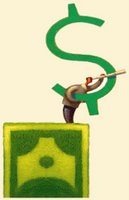Futures Market 100% Certain U.S. Prime Rate Will Hold At 3.25% After The December 15 FOMC Monetary Policy Meeting

If you've been wondering when the Fed is going to start a cycle of raising short-term interest rates, the one macroeconomic figure you need to pay attention to is the unemployment rate. That's because the Bernanke Fed is confident that the nation's jobless rate is going to remain stubbornly high well into 2010 and likely beyond, which in turn will serve as a check on inflation. The Fed is still focused on pumping as much stimulus into the economy as it possibly can, to get the economy back to durable growth as soon as possible. It doesn't want to choke off an economic recover by raising short-term rates too soon, but it also doesn't want to keep rates too low for too long, and spark and raging inflation problem down the road. But here's the bottom line: the Fed believes that high unemployment together with continued housing market woes will act as a powerful economic sedative, keeping both consumer and wholesale prices under control.
Many investors are worried that the Fed is going to have an economic growth bias for too long, and that it will tolerate some inflation in exchange for growth. Just look at the price of gold as one piece of evidence: New York Spot was at $816.30 on November 28, 2008, and closed at $1,176.70 a few days ago (on November 27, 2009.)
Many are also worried about the current state of the dollar, but I'm not. The dollar is cyclical. It's been very low before, and has bounced back every time. When the economy returns to sustainable growth and the Fed back off from being the dominant force in the economy, the dollar will strengthen again, as simple as that.
So, does the Fed have it right about weak employment keeping inflation in check? I think so. With so many Americans out of work, or struggling with reduced hours, or forced to work part-time, consumer spending will be weak for some time. Exacerbating the jobs problem: too many homeowners are upside down with their mortgage; if they sell they lose big, and there's no home equity to tap into, the same home equity which supported strong consumer spending before the housing bust.
The above economic woes are acting as a strong disinflationary force in the economy, and will continue doing so for years -- yes, years.
So don't be surprised if the Fed keeps short-term rates -- including the U.S. Prime Rate -- at superlow levels throughout 2010.
Of course, for the latest and most accurate rate forecast, stay tuned to this blog.
Housing Market News: Some Good, Some Bad
OK, first the bad. The Mortgage Bankers Association (MBA) recently reported that mortgage delinquencies have set a new record high. Here's a clip from the MBA press release:
"...The delinquency rate for mortgage loans on one-to-four-unit residential properties rose to a seasonally adjusted rate of 9.64 percent of all loans outstanding as of the end of the third quarter of 2009, up 40 basis points from the second quarter of 2009, and up 265 basis points from one year ago, according to the Mortgage Bankers Association’s (MBA) National Delinquency Survey. The non-seasonally adjusted delinquency rate increased 108 basis points from 8.86 percent in the second quarter of 2009 to 9.94 percent this quarter...The delinquency rate breaks the record set last quarter. The records are based on MBA data dating back to 1972..."
And now the good: sales of both existing (preowned) and newly built homes improved during October 2009, thanks in no small part to Uncle Sammy's $8,000, first-time homebuyer tax credit (there's also a tax credit of up to $6,500 available for longtime homeowners who purchase a replacement home.) That's good news for the housing market in general, but there's more: the credit has been extended. For more, check out this IRS page.
--
As of right now, the investors who trade in fed funds futures at the Chicago Board of Trade have odds at 100% (as implied by current pricing on contracts) that the FOMC will vote to leave the benchmark target range for the Federal Funds Rate at its current level at the December 15TH, 2009 monetary policy meeting.
Summary of the Latest Prime Rate Forecast:
- Current odds that the Prime Rate will remain at the current 3.25% after the December 15TH, 2009 FOMC monetary policy meeting is adjourned: 100% (certain)
- NB: U.S. Prime Rate = (The Federal Funds Target Rate + 3)
The odds related to federal-funds futures contracts -- widely accepted as the best predictor of where the FOMC will take the benchmark Fed Funds Target Rate -- are constantly changing, so stay tuned for the latest odds.
Labels: disinflation, economic_recovery, economic_stimulus, employment, housing, inflation, odds, prime_rate_forecast, real_estate
|
--> www.FedPrimeRate.com Privacy Policy <--
--> www.FedPrimeRate.com Privacy Policy -- BACKUP<-- CLICK HERE to JUMP to the TOP of THIS PAGE > SITEMAP < |




